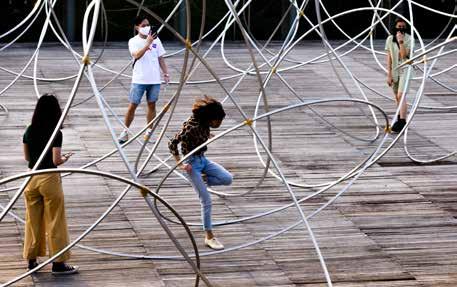
7 minute read
Long-Term Exhibitions
Ongoing | Ng Teng Fong Roof Garden Gallery
Advertisement
Antony Gormley. Horizon Field Singapore, 2021. 47 rings of 23 mm square section aluminium tube and stainless steel spigots. Ring diameter varying from 2 to 5.5m. Image credit: Joseph Nair/ Memphis West Pictures. © the artist
Antony Gormley (b. 1950, United Kingdom) is internationally renowned for his sculptures, installations and public artworks that investigate the relationship between the human body and space. The fifth Ng Teng Fong Roof Garden Commission, Horizon Field Singapore, invites visitors into an immersive experience exploring space and form.
A virtual Curator Tour led by Russell Storer and Qinyi Lim introduces Gormley's evolving practice and invites visitors to consider the relationship between our bodies, nature and the cosmos. The video is available on our website: https://www.nationalgallery.sg/exhibition/ antony-gormley.
Series Partner
The Ng Teng Fong Roof Garden Gallery is made possible with the support of Far East Organization.
ANTONY GORMLEY
Ongoing | Various locations
Three of Gormley’s earlier sculptures—Close V, Sense and Ferment—will also be on display in the Gallery’s public spaces, activating and engaging with the architecture of the buildings.

Antony Gormley Close V 1998 Cast iron 27 × 201 × 174 cm Image credit: Joseph Nair/ Memphis West Pictures © the artist

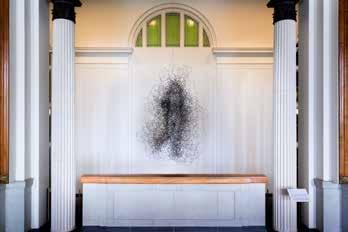
Antony Gormley Ferment 2007 2 mm square section stainless steel bar 273 × 177 × 211 cm Image credit: Joseph Nair/ Memphis West Pictures © the artist Antony Gormley Sense 1991 Concrete 74.5 × 62.5 × 60 cm Image credit: Joseph Nair/ Memphis West Pictures © the artist
Strategic Partner
LONG-TERM EXHIBITIONS
SIAPA NAMA KAMU? ART IN SINGAPORE SINCE THE 19TH CENTURY
Ongoing | City Hall Wing, Level 2, DBS Singapore Gallery

Georgette Chen (张荔英) Hakka Family 1939 Oil on canvas, 162 × 130 cm Private collection
Hakka Family is one of Georgette Chen’s most significant works due to its impressive scale and reflection of Chen’s artistic philosophy that the purpose of art is to elevate everyday subjects. Painted while Chen was in Hong Kong, she applied the techniques that she had honed as a student in Paris in the 1920s to depict the people in and context of her surroundings—something that she would continue to develop after her move to Malaya in 1951.
On display in DBS Singapore Gallery 1.
BETWEEN DECLARATIONS & DREAMS: ART OF SOUTHEAST ASIA SINCE THE 19TH CENTURY
Ongoing | Supreme Court Wing, Levels 3–5, UOB Southeast Asia Gallery
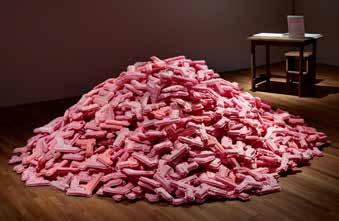
F.X. Harsono What Would You Do If These Crackers Were Real Pistols? 1977–2018 Crackers, table, chair, instructions and notebook, dimensions variable
F.X. Harsono was a key figure in Indonesia’s New Art Movement, a group that emerged in 1975 and sought change through new art forms and contemporary practices. He created this work in 1977 as a political statement against Indonesia’s then-President Suharto’s authoritarian New Order regime. Harsono provokes the viewer to consider the infiltration of violence into everyday life with a simple question: What would you do if these crackers were real pistols?
On display in UOB Southeast Asia Gallery 12.
Lai Foong Moi. Ship. 1960. Oil on canvas, 81.5 × 65.9 cm. In this painting, a familiar urban scene appears streamlined and modern. The shapes of two ships and the silhouettes of workers are simplified such that the image appears to be almost abstract. It was painted by Lai Foong Moi, the first graduate from Singapore’s Nanyang Academy of Fine Arts (NAFA) to study in Paris, where she also exhibited in salon exhibitions.
On display in UOB Southeast Asia Gallery 7.
LONG–TERM EXHIBITIONS
FAMILIAR OTHERS: EMIRIA SUNASSA, EDUARDO MASFERRÉ AND YEH CHI WEI, 1940s–1970s
Opening 4 Aug | Dalam Southeast Asia, Level 3, UOB Southeast Asia Gallery
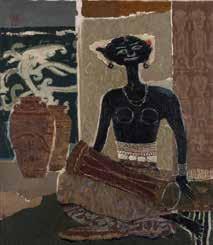
Yeh Chi Wei Drummer 1965 Oil on canvas, 112.5 × 99 cm © Yeh Toh Yen
NEW
Who are our “others”? What does it mean to represent people of a culture or ethnicity other than our own?
Familiar Others explores these issues through the works of three Southeast Asian modern artists. Emiria Sunassa (1894–1964) painted images of peoples from throughout the Indonesian archipelago but had a special interest in Papua. Eduardo Masferré (1909–1995) photographed the peoples of the Cordillera region of the Philippines, where he spent his life. Yeh Chi Wei (1913–1991) travelled throughout Southeast Asia but was especially inspired by the Indigenous peoples of Sarawak and Sabah.
To open up a discussion about the contemporary implications of these works, this exhibition includes commissioned responses from artists, writers, musicians and scholars who have community ties to the people represented in the artworks.
Dalam Southeast Asia is an experimental project space located within the UOB Southeast Asia Gallery. Projects presented here ask critical questions and explore lesser-known narratives in Southeast Asian art while rethinking what a collections-based display is and what it may seek to achieve.
UNREALISED
Ongoing | Accessible only via the Gallery Explorer app

unrealised is a virtual experience developed in dialogue with three artists—Heman Chong, Ho Tzu Nyen and Erika Tan. It tests the potential of the digital image within the physical spaces of the Gallery’s long-term displays. To access unrealised, please download the Gallery Explorer app from the App Store and Google Play store.
For more information, please visit nationalgallery.sg/unrealised.
SCAN TO DOWNLOAD APP
Please note earphones are required to experience unrealised.
LONG–TERM EXHIBITIONS
OUTBOUND
Ongoing | Various locations nationalgallery.sg/outbound #outboundsg

(L-R): Kak Julitah, Yee I-Lann and Kak Roziah. Yee I-Lann (b. 1971, Malaysia) with weaving assistance from Bajau Sama DiLaut weavers led by Kak Roziah: Kak Anjung, Makcik Bagai, Makcik Billung, Makcik Braini, Kak Budi, Kak Ebbuh, Makcik Gangah, Kak Ginnuh, Kak Gultiam, Makcik Indah Laiha, Kak Kanuk, Kak Kinnuhong, Makcik Kuluk, Adik Lornah, Kak Norbaya and Kak Sana; and Dusun Murut weavers led by Julitah Kulinting: Lili Naming, Siat Yanau, Mohd Shahrizan Bin Rupin, Juraen Sapirin, S. Narty Abd. Hairun, Zaitun Abd. Hairun and Julia Ginasius.
Tikar-A-Gagah. 2019. Pandanus weave with commercial chemical dye (front); Split bamboo weave with black natural dye (back); stitched with bamboo weave. On display at the foyer near the Holding Cells, Level 1, Supreme Court Wing.
Tikar-A-Gagah is the result of an 18-month long collaboration between artist Yee I-Lann and indigenous weavers in Sabah, a northern Borneo state in Malaysia. Commissioned for the Gallery’s OUTBOUND series, the artwork features both traditional and contemporary motifs that reveal the process of co-invention between Yee and the weavers, whose traditional motifs are passed down orally from one generation to the next. Tikar-A-Gagah features abstract, maritimeinspired patterns of the Bajau sea communities as well as graphical motifs of landscapes, fauna and communal gatherings of the Dusun and Murut land communities. By drawing on traditional weaving techniques and the symbolism of the tikar in indigenous culture, Tikar-A-Gagah generates new conversations about contemporary forms of art in this region.
OUTBOUND is a series of unique commissions that imaginatively transform transitionary spaces at the Gallery. Each commission is an artistic and temporal landmark that anchors and guides the visitor’s experience while highlighting the Gallery’s iconic architecture. The inaugural season presents projects from artists Gary Carsley (Australia), Jeremy Chu (Singapore), Jane Lee (Singapore), Haegue Yang (South Korea) and Yee I-Lann (Malaysia).
LISTENING TO ARCHITECTURE: THE GALLERY’S HISTORIES AND TRANSFORMATIONS
Ongoing | City Hall Wing, Level 4, ArchiGallery
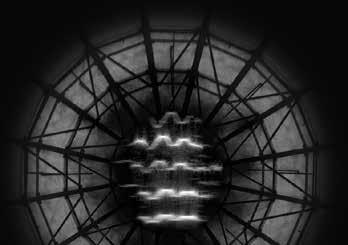
Zai Tang. Resident Frequencies: A Brief Aural History of National Gallery Singapore. 2017. Eight-channel sound installation, 36 mins. Commissioned by National Gallery Singapore. Image courtesy of the artist. The architecture of the City Hall and former Supreme Court buildings may be imagined as an ongoing conversation between different generations across time. The inaugural exhibition at the ArchiGallery offers insights into the enduring histories and architectural designs of the two national monuments and their dramatic transformations into a home for Southeast Asian art. It also features never-before-seen artefacts excavated from the Gallery’s grounds, and a commissioned sonic artwork by artist Zai Tang that draws on the historical, social and spatial memories created in the buildings.
LAW OF THE LAND: HIGHLIGHTS OF SINGAPORE’S CONSTITUTIONAL DOCUMENTS
Ongoing | Supreme Court Wing, Level 3, Chief Justice's Chamber & Office
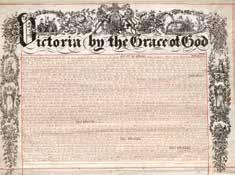
Organised by the National Archives of Singapore (NAS) and the National Library Board (NLB), this exhibition explores the history of Singapore’s constitutional development from a British settlement in 1819 to its emergence as a sovereign republic in 1965. It presents a selection of 23 rare documents from the NAS and NLB's collections, each capturing a key moment in Singapore's legal history and journey to independence.
Third Charter of Justice, 1855
This document affirmed the reception of English law in Singapore and provided the settlement with its own professional judge (then known as a Recorder).








